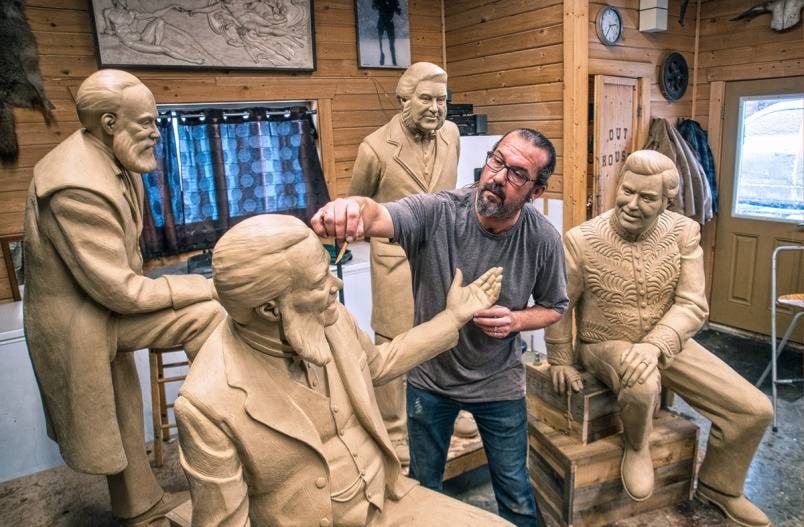A Kamloops sculptor’s work has taken him far back into Canada’s parliamentary history, as he has been tasked with casting four of Canada’s earliest leaders in bronze.
When the work by sculptor Nathan Scott is completed, school groups, tourists and the history-curious will encounter the group of four men along the Prime Ministers Path near the historic Castle Kilbride, just outside of Waterloo, Ont.
From 1891 to 1896, Canada saw four prime ministers in quick succession: John Abbott, John Thompson, Mackenzie Bowell and Charles Tupper.
The path’s current sculpted occupants include prime ministers Kim Campbell, William Lyon Mackenzie King, John A. Macdonald, Lester B. Pearson and another piece done by Scott, Robert Borden.
The current set of four prime ministers is Scott’s largest work to date, and the first he will cast in Kamloops.
When KTW visited Scott at his shop in Knutsford, heavy snow blocked what he could normally see — a view that extends far up the North Thompson Valley, even to Sun Peaks.
“My eyesight is actually getting better now. I can actually see better farther,” he said.
That clarity came with the family’s decision to trade their home on Vancouver Island for one in Knutsford.
On one trip back home, Scott recalled stopping by a realtor in Merritt, entertaining the idea of moving to an area he had always liked. By the time he and his family reached the ferry to cross back home to the island, they had made their decision.
“We said, ‘Let’s move,’” he told KTW. “And, six months later, we did.”
Scott’s new view has brought about changes to much of his work. He shut down the foundry he operated in Saanich and no longer casts bronze for other artists. In fact, he’s only now starting the process to get his own foundry operating once again, where he plans to cast the four prime ministers.
Four clay men currently sit in Scott’s shop, adorned with details outlining their past and setting them in time. To get to this point, it has taken Scott two months, carefully measuring, forming, sculpting and etching details to bring the earthen material to life.
The process involves first creating the sculpture in clay. Once the forms have been finalized, a polyurethane rubber mould is created over the pieces that captures even the finest details. This mould is then used to create a fibreglass mother mould, into which wax is poured, with the thickness of the wax determining the thickness of the final bronze sculpture.
“All bronzes are hollow, except for the little pieces,” Scott said as he explained, showing works around his shop in various stages of what is called the lost-wax process.
The wax is then dipped in a ceramic material and coated in silica sand. A pouring cup is attached that allows the bronze inside.
After the piece is heated up to about 980 C — a necessary step to prevent thermal shock — liquid bronze at a temperature of 1,065 C is poured inside, quickly cooling in about 20 seconds, Scott said.
After 10 minutes, the ceramic shell is cracked off and the piece undergoes a sandblasting treatment, leaving a final form that needs further work to remove rough edges and add colour.
Scott, a 50-year-old father of five, said he has his work cut out for him, with completed sculptures due in Ontario by June 20.
“After I’m done welding all the pieces together, I polish or retexture the welds and do a bronze patina. I use ferric nitrate to get the browns, a silver nitrate to get the silvers, a liver of sulfur to get different colours,” he said.
Those colours will be used to reveal “Easter eggs” — details pertaining to the men’s lives and occupations meant to be noticed by those paying closer attention to the works, like school groups looking for more tactile realizations of what they have already read in books.
One such detail is the object held by Bowell — an orange, hinting at his religious life as past Grandmaster of the North American Orange Order. Other details are more direct, like the stethoscope protruding from Tupper’s jacket pocket — a nod to the former prime minister’s work as a physician.
“You have to do it without ruining the sculpture, so you have to get creative and clever, and it’s been a lot of fun in that sense,” Scott said of the details he has added to his work.
The quartet is the second piece from Scott that has been commissioned by Createscape, the group behind the Prime Ministers Path. But his other commissioned works have landed across Canada, to the point where it’s easier for him to name the provinces his work does not appear in — Saskatchewan, Manitoba and Quebec, to name a few.
His past sculptures include two Terry Fox memorials, Anne of Green Gables author Ella Montgomery in P.E.I., a coal miner in Sparwood, a hockey faceoff in Alberta, Leonard Nimoy as Spock in Vulcan, Alta., a navy seaman and homecoming scene in Victoria and dozens of other public and private commissions, all created over the past 21 years.
With Scott now enjoying rural life just outside Kamloops, he said he is appreciating the slower pace and more beautiful view, thankful to be at the point in his career where he can work from wherever he chooses.
“We just love it. I’m living the dream here,” he said.
Sean Brady, Kamloops This Week
